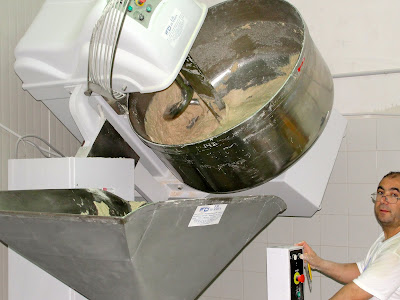


THE STAFF OF LIFE
If you’re easily offended you may want to skip this one; I’m going to use the ‘p’ word. There’s just no way to understand the Mediterranean Diet without confronting the deep-seated Italian love of pane, bread.
And I shall be unapologetic about using the word; despite the relentless attempts on the part of some food Nazis to the contrary, bread is, always has been, and always will be, good food. You could make a case that man’s co-evolution with various grass seeds is the basis for all civilization. It was grass seeds that convinced paleolithic hunter gatherers to settle down and become farmers. It was grass seeds that 'domesticated' humans, that is, convinced them to give up the yurt and settle down in a proper domus (house). Think of corn, rice, quinoa, barley. But in Italy, ancient and modern, that love affair has been with members of the Triticum family, the wheats. And at least as far back as the early second century BCE that love affair has been manifested as leavened bread cooked in a wood-fired oven.
So it was that, several days ago, I made my way at midnight to the Forno Antico Biscottificio on the outskirts of Agropoli. The proprietor, Elio, had been kind enough to give the pazzo Americano access to his facility.
This was traditional baking on an industrial scale, if that makes any sense at all, for this Forno was actually four forni (ovens), three easily capable of baking 70 loaves of panoni at a time, and one monster probably twice that. Such are the financial exigencies of modern artisinal food in Italy: adapt or die. In fact, in this town of some 26,000 inhabitants, a number that grows to 40,000 on summer weekends when the beaches are packed, there is only one other paneficio in town.
Still, the basics of the procedure are there, as are the grueling work and the dedication to craft. When I arrived the forni were being fired for the night’s baking and the breads were being formed. Singh, a young man of Indian extraction, was using a blowtorch to fire up the fuel, contained in a pan at the front of a metallic arm connected to a powerful fan and auger. And the fuel was quite a surprise; the Forno uses hazelnut hulls which they buy by the truckload! While some traditionalists sneer, it makes all the sense in the world; Italy has suffered from deforestation for at least 2,000 years, so wood is an expensive fuel which is minimally renewable, and the nut hulls are otherwise a waste product. Plus, they never really touch the floor of the oven so there are no cinders and ash to remove. But Fernando tells me that some people complain when they don’t find little fragments of charcoal in the bottom crust of a bread because it means it wasn’t cooked in the traditional way. O tempora! O mores!
After the hulls were lit, Singh cranked up the fan and within ten minutes there was a blazing fire in the fire pan and the auger began slowly advancing more of the hulls as the original ones were spent. He then proceeded to repeat the process with the other two forni in this area.
Meanwhile, in the forming room, Elio and another Indian worker, Parmjit (is finding labor in the food industry as difficult in Italy as it is in America?) were forming loaves. Parmjit took small doughs and ran them through a roller machine which flattened the doughs and rolled them neatly into panini, ‘little breads’, which Elio put on a proofing tray. They also showed me panini loaves combined with cured sausage and caciocavallo, a sort of all-in-one sandwich.
Elsewhere Celestino loaded 20 kg bags of semola, hard-wheat flour, of grano integro, whole wheat flour, and so-called 00 (‘double-O’) flour, pretty close to our all-purpose flour, into two enormous mixing bowls, added water and leaven, and began the kneading process. Think of a Kitchen Master on steroids, with a dough hook two feet long and 2 inches in diameter. (Continued below)
No comments:
Post a Comment